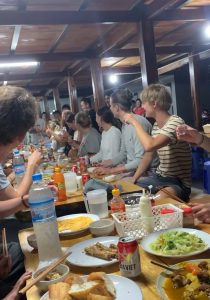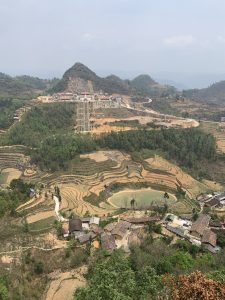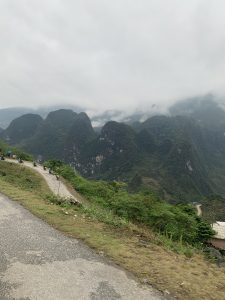





Ha Giang Loop Overview
The Ha Giang Loop tour is a popular motorcycle route in the Ha Giang province of northern Vietnam. The circuit starts and ends in Ha Giang and loops through mountains, valleys, rivers, and ethnic minority villages.
Some of the main attractions along the Ha Giang Loop include the Dong Van Karst Plateau Global Geopark, Ma Pi Leng Pass, Lung Cu Flag Tower (the northernmost point of Vietnam). You also pass through traditional H’mong villages, and natural beauties like the Nho Que River, rice fields, waterfalls and caves.
Since there’s narrow mountain roads with hairpin turns, you need to be comfortable on a motorbike to drive yourself. You should be familiar with unpaved rocky roads, steep uphills/downhills, and navigating stops with lots of other bikes. If you aren’t, you can take the “easy rider” option, where you ride on back of a motorbike with a skilled driver. I generally try to avoid organized tours when possible, as I prefer the freedom to go at my own pace. Since I was not confident in my ability to drive on my own, I did the Ha Giang Loop tour with an easy rider option. I settled on the 3 day, 2 night Ha Giang Loop tour through Buffalo Hostel.
I had heard that popular tours like Jasmine and Mama’s had huge groups, fast drivers, and a big party atmosphere. On the other hand, Buffalo has smaller groups and is more laid back. In this blog post, I’ll share my experience and try to cover any questions you may have.
Pros and Cons
Pros
- Scenic beauty: The trip offers stunning views of mountains, caves, rivers, and rice paddies. Highlights include the Dong Van Karst Plateau Global Geopark, Bac Sum Pass, Heaven’s Gate, Tam Son town, and the Nho Que River.
- Cultural immersion: Participants get to visit traditional villages, interact with local H’mong people, and witness traditional weaving. There are opportunities to learn about the history and culture of the region, such as the H’mong King palace and the Tham Ma Pass.
- Adventure: Riding on motorbikes through winding roads and visiting remote areas adds an adventurous element to the trip. Driving the loop can be exciting for those seeking adrenaline.
- Memorable moments: Cooling off in a pool after a hot day, partaking in the “happy water” chants, and taking the boat on the Nho Que River created lasting memories.
Cons
- Disorganization: Disorganization and a lack of communication plagued the trip. There was confusion around sleeping arrangements, which activities were next and how long we had at stops.
- Accommodation issues: Some accommodations lacked basic amenities like complementary water and toilet paper, which was disappointing. The homestays did not have enough toilets and showers for the number of guests, which made long queues common. My first night, our accomodation did not have any running water or power and the toilet didn’t flush. There was a strong urine stench all night as 10+ people shared the toilet.
- Pressure to drink: If you decline “happy water” (a strong rice wine) shots, be ready for the staff to pressure you and pour you one anyways. This creates discomfort and frustration for those who prefer not to drink.
- Lack of flexibility: Following a fixed schedule limits flexibility in deciding when and how long to stop at various sites.
- High visibility vests: The bright yellow vests were a requirement to wear, as were knee and elbow pads. While this made our group easy to recognize, all the other groups just wore normal clothing. I’m also not convinced the padding would really help in case of an accident, but they sure made my elbows extra sweaty.
Travel from Hanoi to Ha Giang

After grabbing an 8pm sleeper bus, we arrived in Ha Giang around 3am. A random guy was given a list of names to call out. Those people were to exit the bus, while the rest of us stayed on.
Those of us who stayed on the bus got off at a second homestay. Names were called out to leave the bus, a process that seemed to take forever. A few people were told to stand elsewhere. Then, each person one by one had to repeat their names to get on a smaller bus, even those people who were initially separated. A few of us expressed our confusion for this ritual, as it seemed to serve no purpose. Lots of people were sitting on the floor on the smaller bus, although this was proven necessary given how narrow and windy the road to the homestay was.
We arrived at the homestay, and finally were able to sort ourselves into rooms. Our room of about 10 people had no water, which meant we couldn’t wash our hands, flush the toilet, or brush our teeth. I’m no stranger to $5 dorms but this was not meeting my standard for the bare minimum. By the time we were all settled it, it must have been around 3:30am. We tried to get some quick sleep before the 7am breakfast.
Day 1. Ha Giang city – Quan Ba district – Can Ty commune
Hurry up and wait
The unfortunate thing about getting up and ready for 7 was that we didn’t actually start moving until around 11am. There was no communication about what was happening, and whenever someone asked when we’d leave, the answer was “soon”. I was excited to get on the bike, but within 10 minutes we stopped at a hostel again. Once again we had to go through the names, as well as get safety gear, give the self-drivers a lesson, and assign drivers to the bikes.
Once we actually started, I started to forgive the disorganized mess of a morning. The Ha Giang Loop tour began by snaking through the hairpin turns of Dong Van Karst Plateau Global Geopark. We stopped at the Bac Sum Pass and then at Heaven’s Gate to rest, have coffee, and enjoy the scenery. From above, we could see Tam Son town and admire the Twin Mountains of Quản Bạ surrounded by green rice fields.


We continued on to Tam Son town for lunch, which was an unmemorable assortment of vegetables, rice, curry, and stew. There was good variety, so I imagine even picky eaters could find something to enjoy. Afterward, we worked off lunch with a hike from Lùng Khúy to visit the Lùng Khúy cave. After all the stairs with the sun beating down, cooling off in the cave felt incredible. The next destination was the traditional weaving village of Lùng Tám, where we got to see the local H’mong people weave linen. We finished at a homestay in Cán Tỷ, and cooled off in the pool.
Happy water
At dinner, we were all served a shot of “happy water”. Happy water is a rice wine that tastes like gasoline, peer pressure and battery acid. It is accompanied by a chant:
một, hai, ba, do!
hai, ba, do!
hai, ba, uống!
which translates to “One, two, three, cheers! Two, three, cheers! Two, three, drink!”. I’m not a big drinker but I found this ritual fun, and people got really into the chanting.



One thing you need to know about doing a Ha Giang Loop tour: if you have any problems turning down a drink, you’re going to find it challenging. The staff at the homestay and the drivers were very persistent whenever I declined a shot. Saying “no” to a shot did not work. Putting my shot glass upside down and hiding it behind condiments did not work. Eventually I started pouring water into my shot glass, but after a few times the person pouring the shots caught on.
I don’t understand why people don’t understand or respect the word “no”. I tried to remember that they just wanted me to have fun, that there was no malicious intent. But it’s exhausting when a clear “no” is interpreted as “convince me” or “try harder”. I’m tired of clearly outlining my boundaries and having them walked all over, both on this tour and outside of it.
Day 2. Can Ty – Tham Ma – H’mong King palace – Lung Cu – Nho Que – Dong Van
Tham Ma Pass
Our first stop after breakfast was the Tham Ma Pass, a famous winding road in the shape of an S. It used to be a method to test horse. If a horse can carry goods from the bottom of the hill to the top and is still strong, it’s a good horse and will be used for labor. If not, it will be killed and eaten. At the top of the pass, there were plenty of H’mong children with flowers, offering to braid hair.


Vua Meo Mansion and Vuong Palace
Next, we headed to the Vua Meo Mansion, which is over 100 years old and valued at over 150 billion VND. We also heard a bit about the history of the H’mong ethnic group and the legends of the Meo King Palace. Vuong Chinh Duc was the Bezos of his time thanks to his booming opium production and trade across borders. To protect his reign, he built the 1120 square meter Vuong Palace in Sa Phin Commune. It was designed with Chinese architecture and interior and surrounded by 700 century-old trees to keep it hidden and protected from enemies.


Lung Cu
We continued heading north towards Lung Cu commune to see the northernmost point of the country, the Lung Cu Flag Tower. As we approached the flag tower, we entered on some beautifully paved multi-lane roads. Most of the roads so far have been narrow and in need of a bit of maintenance, so this grand entrance felt very out of place. Naturally, our bikes were the only ones actually using the road, aside from a guy walking his buffalo. I felt like I was in a post-apocalyptic movie. After we climbed the 400 steps to the top of the tower, we were able to get up close to the largest flag in Vietnam. From the top, you can see the China border, about 3km away.
Nho Que River
We were given face masks after our lunch in Dong Van. We passed through rugged cliffs, deep valleys, and got to see the Nho Que River from above at Ma Pi Leng Pass. The view was stunning, but we could see several fires. It is a traditional farming practice to burn crops at the end of the farming cycle, which is said to improve the soil quality for the next season. Unfortunately, this can lead to poor visibility and increased pollution during this time of year.


Our next stop was to take a boat trip on the Nho Que River. This involved a lot of elevation loss and the rugged downhill left my ass a bit sore. I’m glad we made the journey, though, as the boat trip was beautiful and relaxing.
We had dinner in town at a place within a short walk from our homestay. I left early after dinner in attempt to avoid the pressure to drink. This is when my driver chased me down to road yelling “happy water! happy water!”. I ignored him and kept walking but was left frustrated.
Day 3: Du Gia – Meo Vac – Mau Due – Thai An – Ha Giang
After starting breakfast in Dong Van, a big thunderstorm hit. The torrential downpour made the roads unsafe to drive, and power went off in the restaurant. We waited a few hours for the weather to clear, and then were given rain ponchos for the next leg of the journey. Our group already stood out with our high visibility vests, but we definitely looked sexy now with bright blue rain ponchos and shoe covers.
We went back to Ma Pi Leng Pass to reach Meo Vac. It was still lightly raining, so I was much colder than the other days. I liked seeing the pass in the rain, though. It had a mysterious vibe, passing through the mountains and clouds.
We stopped for lunch in Mau Due town, and then visited the Duong Thuong commune in Yen Minh district. The vast cornfields on both sides of the road have been cultivated by the locals for generations.



At around 7pm, we arrived at the homestay and hung out there until it was time to catch the night bus for our next destinations. My driver didn’t come to take me to the bus, so a few other people and I had to wait around until we were able to get someone to drive us. Once we were finally at the bus stop, the most popular next destinations were Sapa, Ninh Binh, Halong, and Hanoi.
Frequently asked questions
When is the best time to visit Ha Giang?
The best time to visit Ha Giang is from October to November, when the weather is moderate and the rice terraces are at their most vibrant. April to June is also a good period, with blooming flowers and pleasant weather. It is not ideal to do the loop from January to March, as the weather can be quite cold. In the summer, rain can make the roads dangerous.
What should I wear?
Bring a lot of layers, and be sure to pack rain gear regardless of the season. I visited in the spring and wore both shorts and leggings depending on the day. My top layers included a tank top, long sleeve shirt, sweater, and down jacket, all of which were worn at different points. The mornings and evenings can be quite brisk, but midday temperatures hit 30C (85F) during my time.
Keep in mind that when you are on the bike, the wind will cool you down a lot.
Does it get cold?
Yes, Ha Giang can get quite cold, especially during the winter months from November to February. Temperatures can drop to around 5-10°C (40-50°F). Even during other seasons, mornings and evenings can be chilly due to the mountainous terrain.
How do I get to Ha Giang?
The most popular method is by bus, especially via an overnight bus from Hanoi which takes around 6-7 hours. It’s also possible to take a day bus, and busses from other locations are also possible. I recommend asking your hostel/hotel for more information, as they can arrange it for you.
How big was the group with Buffalo Hostel?
The group consisted of around 60 people, a combination of those doing 3D2N and 4D2N. Each group had a slightly different schedule, so I was only with the 3D2N group of around 30 people throughout the day. At the homestays, the whole group of 60 would stay at the same place, so it was possible to catch up with friends who were doing the longer tour. The start and end times of each day were tapered, so the 3D2N group had breakfast and dinner before the other group. This kept things manageable, although if I were to do it again, I would go with a smaller maximum group size.
Conclusion
That concludes my journey on the Ha Giang loop. I absolutely think it’s worth doing, but I would highly recommend doing it without a tour if you’re able to drive yourself. The spots were very crowded as each hostel/tour group follows a similar schedule, and the lack of flexibility in when to stop, how long to stop, and so forth can be frustrating. If I were to do it again, I would pick a smaller tour or find a group of friends to do it with, so that we could fully experience the beauty and serenity of northern Vietnam.



